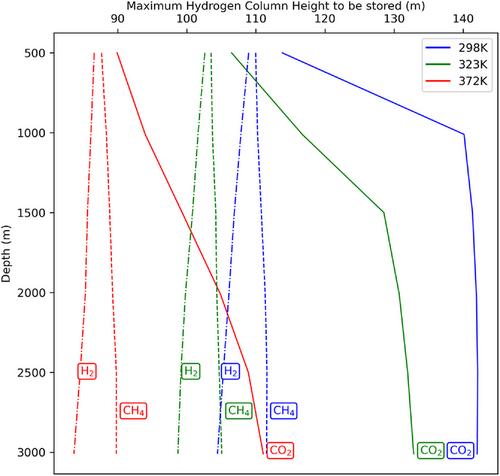下载PDF
{"title":"Synergies of storing hydrogen at the crest of \n \n \n CO\n 2\n \n ${\\rm CO}_{2}$\n or other gas storage","authors":"Sabrine Ben Rhouma, Salaheddine Chabab, Daniel Broseta","doi":"10.1002/ghg.2278","DOIUrl":null,"url":null,"abstract":"<p>There are mutual benefits in storing <span></span><math>\n <semantics>\n <msub>\n <mi>H</mi>\n <mn>2</mn>\n </msub>\n <annotation>${\\rm H}_2$</annotation>\n </semantics></math> in sedimentary reservoirs jointly with another gas serving as a cushion gas, such as the <span></span><math>\n <semantics>\n <msub>\n <mi>CO</mi>\n <mn>2</mn>\n </msub>\n <annotation>${\\rm CO}_2$</annotation>\n </semantics></math> of a carbon capture and storage (CCS) operation or the natural gas of seasonal storage or left in a depleted hydrocarbon reservoir. When <span></span><math>\n <semantics>\n <msub>\n <mi>H</mi>\n <mn>2</mn>\n </msub>\n <annotation>${\\rm H}_2$</annotation>\n </semantics></math> occupies the crest of the reservoir, the presence of either gas is beneficial to the other. <span></span><math>\n <semantics>\n <msub>\n <mi>H</mi>\n <mn>2</mn>\n </msub>\n <annotation>${\\rm H}_2$</annotation>\n </semantics></math> reinforces the sealing efficiency of the caprock due to its very favorable interfacial properties with respect to brine and rock-forming minerals. <span></span><math>\n <semantics>\n <msub>\n <mi>H</mi>\n <mn>2</mn>\n </msub>\n <annotation>${\\rm H}_2$</annotation>\n </semantics></math> storage safety and capacity are also increased with cushion gases such as <span></span><math>\n <semantics>\n <msub>\n <mi>CO</mi>\n <mn>2</mn>\n </msub>\n <annotation>${\\rm CO}_2$</annotation>\n </semantics></math>, which alleviate the buoyancy pressure at the top of the gas column. The potential drawback of this storage scheme is gas/gas mixing, which can, however, be strongly reduced if, by an appropriate choice of well completion and placement, <span></span><math>\n <semantics>\n <msub>\n <mi>H</mi>\n <mn>2</mn>\n </msub>\n <annotation>${\\rm H}_2$</annotation>\n </semantics></math> is positioned in the upper zones of the reservoir, and its injection rate is kept below a critical value corresponding to the incipient fingering instability of the <span></span><math>\n <semantics>\n <mrow>\n <msub>\n <mi>H</mi>\n <mn>2</mn>\n </msub>\n <mrow>\n <mo>/</mo>\n <mi>cushion</mi>\n </mrow>\n </mrow>\n <annotation>${\\rm H}_2{/{\\rm cushion}}$</annotation>\n </semantics></math> gas mixing zone. This value, which depends on reservoir permeability, the dip angle of the mixing front, and how density varies with viscosity in the mixing front, turns out to be well above practical injection rates. Therefore, dispersive mixing is the only cause of front spreading, which is acceptable for not-too-heterogeneous reservoirs. The mutual benefits identified in this study are the strongest when the cushion is made up of dense <span></span><math>\n <semantics>\n <msub>\n <mi>CO</mi>\n <mn>2</mn>\n </msub>\n <annotation>${\\rm CO}_2$</annotation>\n </semantics></math>, which suggests that the crest of offshore <span></span><math>\n <semantics>\n <msub>\n <mi>CO</mi>\n <mn>2</mn>\n </msub>\n <annotation>${\\rm CO}_2$</annotation>\n </semantics></math> storage reservoirs is a good candidate for <span></span><math>\n <semantics>\n <msub>\n <mi>H</mi>\n <mn>2</mn>\n </msub>\n <annotation>${\\rm H}_2$</annotation>\n </semantics></math> storage. © 2024 The Authors. <i>Greenhouse Gases: Science and Technology</i> published by Society of Chemical Industry and John Wiley & Sons Ltd.</p>","PeriodicalId":12796,"journal":{"name":"Greenhouse Gases: Science and Technology","volume":"14 4","pages":"587-606"},"PeriodicalIF":2.8000,"publicationDate":"2024-05-20","publicationTypes":"Journal Article","fieldsOfStudy":null,"isOpenAccess":false,"openAccessPdf":"https://onlinelibrary.wiley.com/doi/epdf/10.1002/ghg.2278","citationCount":"0","resultStr":null,"platform":"Semanticscholar","paperid":null,"PeriodicalName":"Greenhouse Gases: Science and Technology","FirstCategoryId":"93","ListUrlMain":"https://scijournals.onlinelibrary.wiley.com/doi/10.1002/ghg.2278","RegionNum":4,"RegionCategory":"环境科学与生态学","ArticlePicture":[],"TitleCN":null,"AbstractTextCN":null,"PMCID":null,"EPubDate":"","PubModel":"","JCR":"Q3","JCRName":"ENERGY & FUELS","Score":null,"Total":0}
引用次数: 0
引用
批量引用
Abstract
There are mutual benefits in storing
H
2
${\rm H}_2$
in sedimentary reservoirs jointly with another gas serving as a cushion gas, such as the
CO
2
${\rm CO}_2$
of a carbon capture and storage (CCS) operation or the natural gas of seasonal storage or left in a depleted hydrocarbon reservoir. When
H
2
${\rm H}_2$
occupies the crest of the reservoir, the presence of either gas is beneficial to the other.
H
2
${\rm H}_2$
reinforces the sealing efficiency of the caprock due to its very favorable interfacial properties with respect to brine and rock-forming minerals.
H
2
${\rm H}_2$
storage safety and capacity are also increased with cushion gases such as
CO
2
${\rm CO}_2$
, which alleviate the buoyancy pressure at the top of the gas column. The potential drawback of this storage scheme is gas/gas mixing, which can, however, be strongly reduced if, by an appropriate choice of well completion and placement,
H
2
${\rm H}_2$
is positioned in the upper zones of the reservoir, and its injection rate is kept below a critical value corresponding to the incipient fingering instability of the
H
2
/
cushion
${\rm H}_2{/{\rm cushion}}$
gas mixing zone. This value, which depends on reservoir permeability, the dip angle of the mixing front, and how density varies with viscosity in the mixing front, turns out to be well above practical injection rates. Therefore, dispersive mixing is the only cause of front spreading, which is acceptable for not-too-heterogeneous reservoirs. The mutual benefits identified in this study are the strongest when the cushion is made up of dense
CO
2
${\rm CO}_2$
, which suggests that the crest of offshore
CO
2
${\rm CO}_2$
storage reservoirs is a good candidate for
H
2
${\rm H}_2$
storage. © 2024 The Authors. Greenhouse Gases: Science and Technology published by Society of Chemical Industry and John Wiley & Sons Ltd.
在 CO2${rm CO}_{2}$ 或其他气体储存的顶峰储存氢气的协同效应
在沉积储层中与作为缓冲气的另一种气体共同储存,如碳捕集与封存(CCS)作业或季节性储存的天然气或留在枯竭碳氢化合物储层中的天然气,是互惠互利的。由于缓冲气与盐水和成岩矿物之间的界面特性非常有利,因此可加强盖岩的密封效率。缓冲气(如Ⅴ)可减轻气柱顶部的浮力压力,从而提高储藏安全性和容量。这种储气方案的潜在缺点是气体/气体混合,但如果选择适当的完井方式和位置,将气井置于储层的上部区域,并将注入速度控制在气体混合区初期指状不稳定性的临界值以下,则可以大大减少气体/气体混合。该值取决于储层渗透率、混合前沿的倾角以及密度随混合前沿粘度的变化情况,结果远高于实际注入率。因此,分散混合是造成前沿扩散的唯一原因,这对于不是太均质的储层来说是可以接受的。本研究发现,当缓冲层由致密的Ⅴ类物质组成时,互利性最强,这表明海上储油层的峰顶是储油的良好候选地。© 2024 作者。温室气体:科学与技术》由化学工业协会和 John Wiley & Sons Ltd. 出版。
本文章由计算机程序翻译,如有差异,请以英文原文为准。



 求助内容:
求助内容: 应助结果提醒方式:
应助结果提醒方式:


